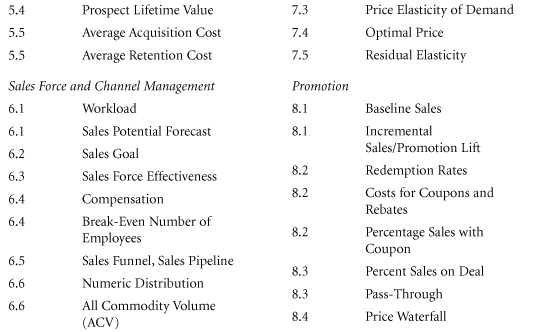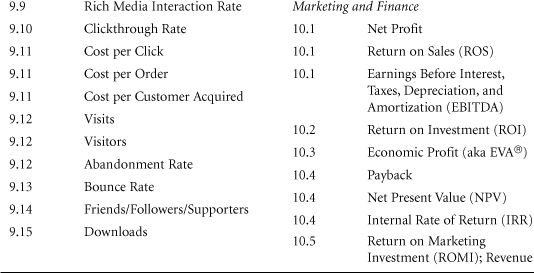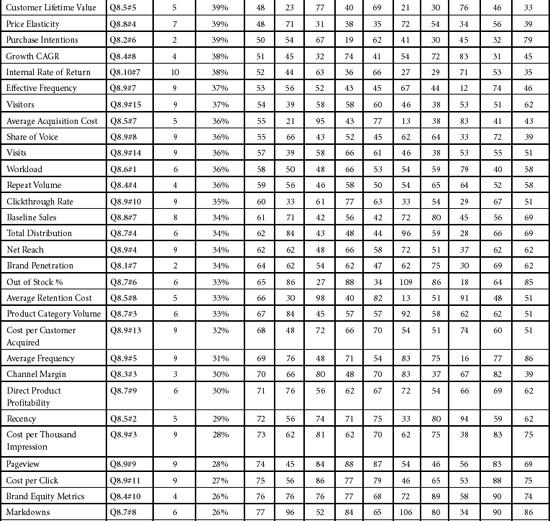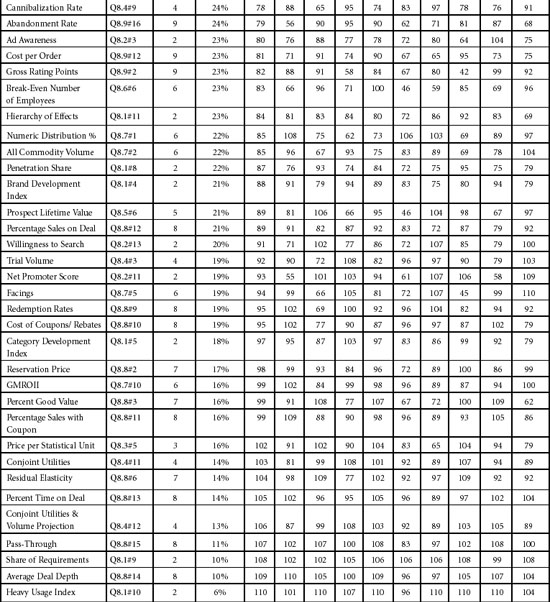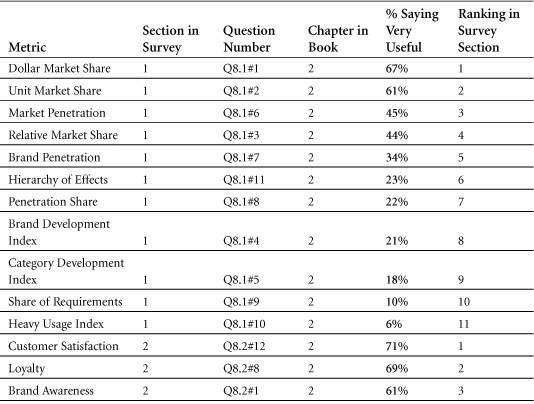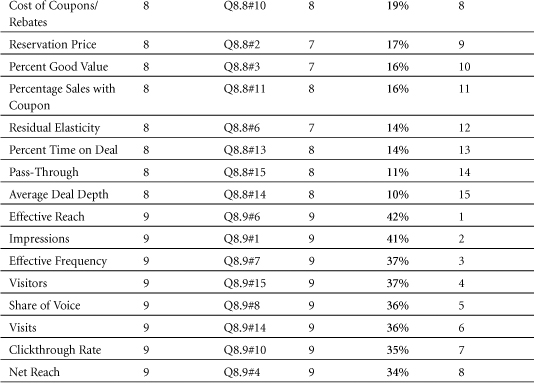1. Introduction
In recent years, data-based marketing has swept through the business world. In its wake, measurable performance and accountability have become the keys to marketing success. However, few managers appreciate the range of metrics by which they can evaluate marketing strategies and dynamics. Fewer still understand the pros, cons, and nuances of each.
In this environment, we have come to recognize that marketers, general managers, and business students need a comprehensive, practical reference on the metrics used to judge marketing programs and quantify their results. In this book, we seek to provide that reference. We wish our readers great success with it.
1.1 What Is a Metric?
A metric is a measuring system that quantifies a trend, dynamic, or characteristic.1 In virtually all disciplines, practitioners use metrics to explain phenomena, diagnose causes, share findings, and project the results of future events. Throughout the worlds of science, business, and government, metrics encourage rigor and objectivity. They make it possible to compare observations across regions and time periods. They facilitate understanding and collaboration.
1.2 Why Do You Need Metrics?
“When you can measure what you are speaking about, and express it in numbers, you know something about it; but when you cannot measure it, when you cannot express it in numbers, your knowledge is of a meager and unsatisfactory kind: it may be the beginning of knowledge, but you have scarcely, in your thoughts, advanced to the stage of science.”—William Thomson, Lord Kelvin, Popular Lectures and Addresses (1891–94)2
Lord Kelvin, a British physicist and the manager of the laying of the first successful transatlantic cable, was one of history’s great advocates for quantitative investigation. In his day, however, mathematical rigor had not yet spread widely beyond the worlds of science, engineering, and finance. Much has changed since then.
Today, numerical fluency is a crucial skill for every business leader. Managers must quantify market opportunities and competitive threats. They must justify the financial risks and benefits of their decisions. They must evaluate plans, explain variances, judge performance, and identify leverage points for improvement––all in numeric terms. These responsibilities require a strong command of measurements and of the systems and formulas that generate them. In short, they require metrics.
Managers must select, calculate, and explain key business metrics. They must understand how each is constructed and how to use it in decision-making. Witness the following, more recent quotes from management experts:
“… every metric, whether it is used explicitly to influence behavior, to evaluate future strategies, or simply to take stock, will affect actions and decisions.”3
“If you can’t measure it, you can’t manage it.”4
1.3 Marketing Metrics: Opportunities, Performance, and Accountability
Marketers are by no means immune to the drive toward quantitative planning and evaluation. Marketing may once have been regarded as more an art than a science. Executives may once have cheerfully admitted that they knew they wasted half the money they spent on advertising, but they didn’t know which half. Those days, however, are gone.
Today, marketers must understand their addressable markets quantitatively. They must measure new opportunities and the investment needed to realize them. Marketers must quantify the value of products, customers, and distribution channels––all under various pricing and promotional scenarios. Increasingly, marketers are held accountable for the financial ramifications of their decisions. Observers have noted this trend in graphic terms:
“For years, corporate marketers have walked into budget meetings like neighborhood junkies. They couldn’t always justify how well they spent past handouts or what difference it all made. They just wanted more money––for flashy TV ads, for big-ticket events, for, you know, getting out the message and building up the brand. But those heady days of blind budget increases are fast being replaced with a new mantra: measurement and accountability.”5
1.4 Choosing the Right Numbers
The numeric imperative represents a challenge, however. In business and economics, many metrics are complex and difficult to master. Some are highly specialized and best suited to specific analyses. Many require data that may be approximate, incomplete, or unavailable.
Under these circumstances, no single metric is likely to be perfect. For this reason, we recommend that marketers use a portfolio or “dashboard” of metrics. By doing so, they can view market dynamics from various perspectives and arrive at “triangulated” strategies and solutions. Additionally, with multiple metrics, marketers can use each as a check on the others. In this way, they can maximize the accuracy of their knowledge.6 They can also estimate or project one data point on the basis of others. Of course, to use multiple metrics effectively, marketers must appreciate the relations between them and the limitations inherent in each.
When this understanding is achieved, however, metrics can help a firm maintain a productive focus on customers and markets. They can help managers identify the strengths and weaknesses in both strategies and execution. Mathematically defined and widely disseminated, metrics can become part of a precise, operational language within a firm.
Data Availability and Globalization of Metrics
A further challenge in metrics stems from wide variations in the availability of data between industries and geographies. Recognizing these variations, we have tried to suggest alternative sources and procedures for estimating some of the metrics in this book.
Fortunately, although both the range and type of marketing metrics may vary between countries,7 these differences are shrinking rapidly. Ambler,8 for example, reports that performance metrics have become a common language among marketers, and that they are now used to rally teams and benchmark efforts internationally.
1.5 Mastering Metrics
Being able to “crunch the numbers” is vital to success in marketing. Knowing which numbers to crunch, however, is a skill that develops over time. Toward that end, managers must practice the use of metrics and learn from their mistakes. By working through the examples in this book, we hope our readers will gain both confidence and a firm understanding of the fundamentals of data-based marketing. With time and experience, we trust that you will also develop an intuition about metrics, and learn to dig deeper when calculations appear suspect or puzzling.
Ultimately, with regard to metrics, we believe many of our readers will require not only familiarity but also fluency. That is, managers should be able to perform relevant calculations on the fly––under pressure, in board meetings, and during strategic deliberations and negotiations. Although not all readers will require that level of fluency, we believe it will be increasingly expected of candidates for senior management positions, especially those with significant financial responsibility. We anticipate that a mastery of data-based marketing will become a means for many of our readers to differentiate and position themselves for career advancement in an ever more challenging environment.
Organization of the Text
This book is organized into chapters that correspond to the various roles played by marketing metrics in enterprise management. Individual chapters are dedicated to metrics used in promotional strategy, advertising, and distribution, for example. Each chapter is composed of sections devoted to specific concepts and calculations.
We must present these metrics in a sequence that will appear somewhat arbitrary. In organizing this text, we have sought to strike a balance between two goals: (1) to establish core concepts first and build gradually toward increasing sophistication, and (2) to group related metrics in clusters, helping our readers recognize patterns of mutual reinforcement and interdependence. In Figure 1.1, we offer a graphical presentation of this structure, demonstrating the interlocking nature of all marketing metrics––indeed of all marketing programs––as well as the central role of the customer.
The central issues addressed by the metrics in this book are as follows:
• Chapter 2—Share of Hearts, Minds, and Markets: Customer perceptions, market share, and competitive analysis.
• Chapter 3—Margins and Profits: Revenues, cost structures, and profitability.
• Chapter 4—Product and Portfolio Management: The metrics behind product strategy, including measures of trial, growth, cannibalization, and brand equity.
• Chapter 5—Customer Profitability: The value of individual customers and relationships.
• Chapter 6—Sales Force and Channel Management: Sales force organization, performance, and compensation. Distribution coverage and logistics.
• Chapter 7—Pricing Strategy: Price sensitivity and optimization, with an eye toward setting prices to maximize profits.
Figure 1.1 Marketing Metrics: Marketing at the Core of the Organization
• Chapter 8—Promotion: Temporary price promotions, coupons, rebates, and trade allowances.
• Chapter 9—Advertising Media and Web Metrics: The central measures of advertising coverage and effectiveness, including reach, frequency, rating points, and impressions. Models for consumer response to advertising. Specialized metrics for Web-based campaigns.
• Chapter 10—Marketing and Finance: Financial evaluation of marketing programs.
• Chapter 11—The Marketing Metrics X-Ray: The use of metrics as leading indicators of opportunities, challenges, and financial performance.
• Chapter 12—System of Metrics: Decomposing marketing metrics into component parts can improve measurement accuracy, add managerial insight into problems, and assist marketing model building.
Components of Each Chapter
As shown in Table 1.1, the chapters are composed of multiple sections, each dedicated to specific marketing concepts or metrics. Within each section, we open with definitions, formulas, and a brief description of the metrics covered. Next, in a passage titled Construction, we explore the issues surrounding these metrics, including their formulation, application, interpretation, and strategic ramifications. We provide examples to illustrate calculations, reinforce concepts, and help readers verify their understanding of key formulas. That done, in a passage titled Data Sources, Complications, and Cautions, we probe the limitations of the metrics under consideration and potential pitfalls in their use. Toward that end, we also examine the assumptions underlying these metrics. Finally, we close each section with a brief survey of Related Metrics and Concepts.
In organizing the text in this way, our goal is straightforward: Most of the metrics in this book have broad implications and multiple layers of interpretation. Doctoral theses could be devoted to many of them, and have been written about some. In this book, however, we want to offer an accessible, practical reference. If the devil is in the details, we want to identify, locate, and warn readers against him, but not to elaborate his entire demonology. Consequently, we discuss each metric in stages, working progressively toward increasing levels of sophistication. We invite our readers to sample this information as they see fit, exploring each metric to the depth that they find most useful and rewarding.
With an eye toward accessibility, we have also avoided advanced mathematical notation. Most of the calculations in this book can be performed by hand, on the back of the proverbial envelope. More complex or intensive computations may require a spreadsheet. Nothing further should be needed.
Reference Materials
Throughout this text, we have highlighted formulas and definitions for easy reference. We have also included outlines of key terms at the beginning of each chapter and section. Within each formula, we have followed this notation to define all inputs and outputs.
$—(Dollar Terms): A monetary value. We have used the dollar sign and “dollar terms” for brevity, but any other currency, including the euro, yen, dinar, or yuan, would be equally appropriate.
%—(Percentage): Used as the equivalent of fractions or decimals. For readability, we have intentionally omitted the step of multiplying decimals by 100 to obtain percentages.
#—(Count): Used for such measures as unit sales or number of competitors.
R—(Rating): Expressed on a scale that translates qualitative judgments or preferences into numeric ratings. Example: A survey in which customers are asked to assign a rating of “1” to items that they find least satisfactory and “5” to those that are most satisfactory. Ratings have no intrinsic meaning without reference to their scale and context.
I—(Index): A comparative figure, often linked to or expressive of a market average. Example: the consumer price index. Indexes are often interpreted as a percentage.
References and Suggested Further Reading
Abela, Andrew, Bruce H. Clark, and Tim Ambler. “Marketing Performance Measurement, Performance, and Learning,” working paper, September 1, 2004.
Ambler, Tim, and Chris Styles. (1995). “Brand Equity: Toward Measures That Matter,” working paper No. 95-902, London Business School, Centre for Marketing.
Barwise, Patrick, and John U. Farley. (2003). “Which Marketing Metrics Are Used and Where?” Marketing Science Institute, (03-111), working paper, Series issues two 03-002.
Clark, Bruce H., Andrew V. Abela, and Tim Ambler. “Return on Measurement: Relating Marketing Metrics Practices to Strategic Performance,” working paper, January 12, 2004.
Hauser, John, and Gerald Katz. (1998). “Metrics: You Are What You Measure,” European Management Journal, Vo. 16, No. 5, pp. 517–528.
Kaplan, R. S., and D. P. Norton. (1996). The Balanced Scorecard: Translating Strategy into Action, Boston, MA: Harvard Business School Press.

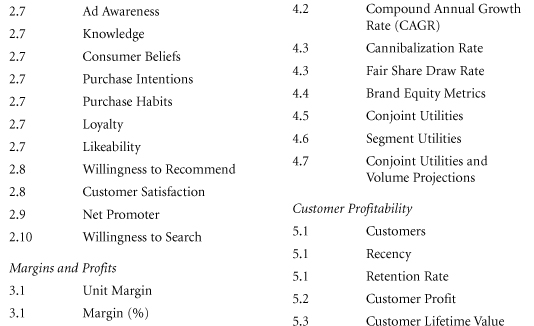
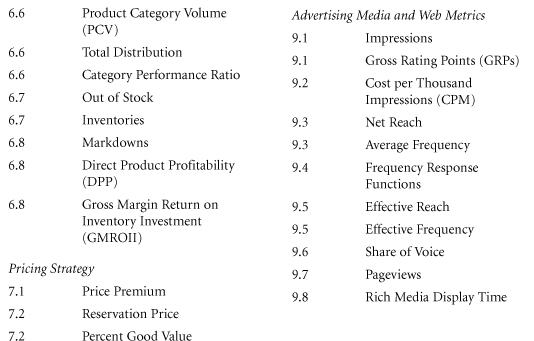
1.6 Marketing Metrics Survey
Why Do a Survey of Which Metrics Are Most Useful?
From the beginning of our work on this book, we have fielded requests from colleagues, editors, and others to provide a short list of the “key” or “top ten” marketing metrics. The intuition behind this request is that readers (managers and students) ought to be able to focus their attention on the “most important” metrics. Until now we have resisted that request.
Our reasons for not providing the smaller, more concentrated list of “really important” metrics are as follows. First, we believe that any ranking of marketing metrics from most to least useful will depend on the type of business under consideration. For example, marketers of business-to-business products and services that go to market through a direct sales force don’t need metrics that measure retail availability or dealer productivity.
The second reason we believe that different businesses will have different rankings is that metrics tend to come in matched sets. For example, if customer lifetime value is important to your business (let’s say, financial services), then you are likely to value measures of retention and acquisition costs as well. The same notion applies to retail, media, sales force, and Web traffic metrics. If some of these are important to you, others in the same general categories are likely to be rated as useful, too.
Third, businesses don’t always have access (at a reasonable cost) to the metrics they would like to have. Inevitably, some of the rankings presented will reflect the cost of obtaining the data that underlie the particular metrics.
Fourth, some metrics might be ranked lower, but ultimately prove to be useful, after managers fully understand the pros and cons of a particular metric. For example, many believe that Economic Value Added (EVA) is the “gold standard” of profitability metrics, but it ranks far below other financial performance measures such as ROI. We believe one reason for the low ranking of EVA is that this metric is less applicable at the “operating level” than for overall corporate performance. The other reason is that the measure is relatively new, and many managers don’t understand it as well. Customer Lifetime Value is another metric that is gaining acceptance, but is still unfamiliar to many managers. If all these metrics were well understood, there would be no need for a book of this type.
In summary, while we believe the rankings resulting from our survey can be useful, we ask readers to keep the above points in mind. We report in Tables 1.2 (page 13) and 1.3 (page 21) the overall ranking of the usefulness of various metrics as well as the different rankings for different types of businesses and different categories of metrics. Although no business is likely to be exactly like yours, we thought readers might find it useful to see what other marketers thought which metrics were most useful in monitoring and managing their businesses. For a look at the complete survey, see Appendix A.
Survey Sample
Our survey was completed by 194 senior marketing managers and executives. More than 100 held the title of Vice President/Director/Manager or “Head” of Marketing, some with global responsibility. Most held titles such as VP of Marketing, Marketing Director, and Director Sales and Marketing. There were 10 presidents and C-level managers with heavy marketing responsibilities, and the remaining respondents included product/project/category managers, trade marketing managers, pricing managers, key account managers, development managers, and assistant/associate vice presidents.
Industries represented in our survey are too diverse to easily summarize. No more than 10 responses from a single industry were recorded, and the respondents listed their markets as aerospace, automobiles, banking, chemicals, consumer goods, construction, computers, consulting, education, industrial distribution, investments, government, health care, housing, insurance, information technology, manufacturing, materials, medical devices, paints, pharmaceuticals, retailing, software, telecommunications, and transportation. Roughly 20% of respondents did not provide a specific industry.
Survey questions asked respondents to rate the usefulness of particular metrics in monitoring and managing their businesses. Note that this survey asks managers to give ratings with respect to how these metrics are actually used but does not inquire about the reason. Nor did the survey offer guidance concerning the meaning of “useful”—that was left as a matter of interpretation for survey participants.
Financial metrics are generally rated very high in usefulness compared to any true marketing metrics. This is not surprising given that financial metrics are common to almost every business.
Table 1.2 Survey of Senior Marketing Managers on the Perceived Usefulness of Various Marketing Metrics (n = 194)
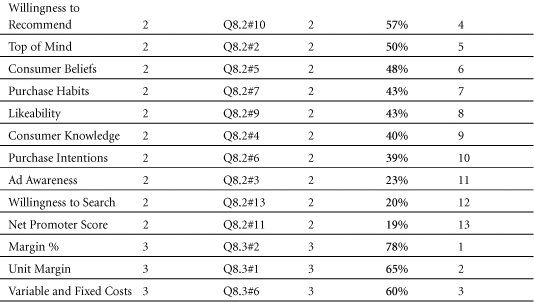

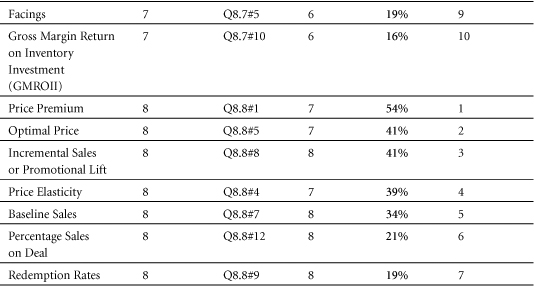
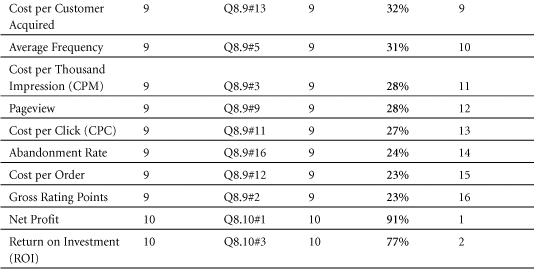
Table 1.3 Ranking of Metrics by Category/Chapter (See Appendix A for complete survey)


